Air conditioners are pretty cool. But there’s an increasingly popular variety of them that figuratively and literally sucks. Portable air conditioners seem to be taking the world by storm, or at least have taken the air conditioner isle of the hardware store by storm.
Are portable air conditioners worth the money? From our humble opinion, no.
Do portable air conditioners really work?
No. Portable air conditioners are actually kinda…bad.
Now it’s not like they don’t work! And some of them aren’t quite as bad as most. Plus, they can really come in handy. Sometimes portable air conditioner fills with water quickly too.
This one here is serving duty precisely because the window it’s venting through isn’t really suited to holding a window unit in place with any sense of confidence. And I know because I tried.
Yes, this here is the symbol of my shame. The air conditioner was never meant to be. But luckily for you, I didn’t return it because it’s gonna be a great visual aid!
Now, in this article, I’m going to argue that if you need an air conditioner you should gravitate towards these simple window units and away from those trendy portable units if you can. And to find out why we need to learn a little bit about air conditioning.
Air conditioners are mechanical devices that collect and concentrate heat energy in order to move it from one place to another. The cold air they create is in fact ordinary air that’s had its heat energy sucked right out of it. And of course, we can’t just bottle that energy up (though that would be super cool if we could figure that out) so instead, we move it somewhere else–usually to the outside air.
And inside every air conditioner, you’ll find three essential parts that make that happen. This is the basis of nearly every air conditioning and refrigeration system in service today.
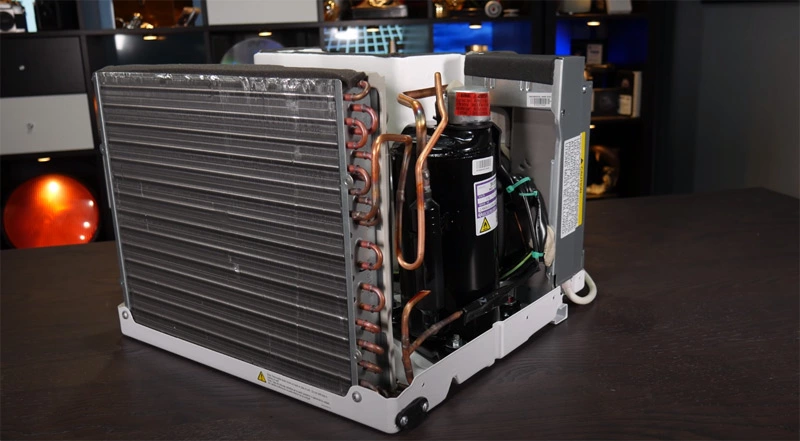
The black cylinder contains a compressor that squeezes a gas called a refrigerant into a small space, decreasing its volume and increasing the pressure it’s under. The high-pressure gas, which has now gotten quite hot thanks to the fact that it just got compressed, travels through these pipes into the second key component; the condenser.
The condenser is a heat exchanger designed to cool that hot gas down as quickly as possible. The densely spaced fins increase its surface area to speed up the heat transfer, and a fan helps to speed it along even more by blowing air across the fins.
Since the refrigerant is now pressurized, its boiling point has increased. And in fact, its boiling point has increased so much that once we get it down to something like 130 or 150 degrees, it will condense into a liquid. So, as the hot gas winds its way through all these pipes and its heat energy gets transferred to the air, it slowly turns into a liquid, releasing a ton of heat energy as it does so.
Now here’s where the magic happens. That liquid is being held back by a metering device such as a thermal expansion valve, to keep the pressure high in the condenser and limit the amount of liquid refrigerant that can pass through.
This basic air conditioner uses a capillary tube, a long copper tube with a very small internal diameter, to restrict the refrigerant and thus limit its flow. But once it makes it through to the other side, it finds itself in a second heat exchanger, called the evaporator.
This one is functionally identical to the condenser, except the pressure inside here is much, much lower thanks to the suction created by the intake side of the compressor. Once inside here, the refrigerant can relax, and its boiling point suddenly shoots way down, like into the well-below-zero territory.
And that means it’s gonna spontaneously boil –or evaporate– because, well, it’s too hot for it to remain a liquid. But to change phases back into a gas, it needs to get energy from somewhere. And luckily, the fins of the evaporator help it absorb the energy in the room, and the effect is that the room gets colder.
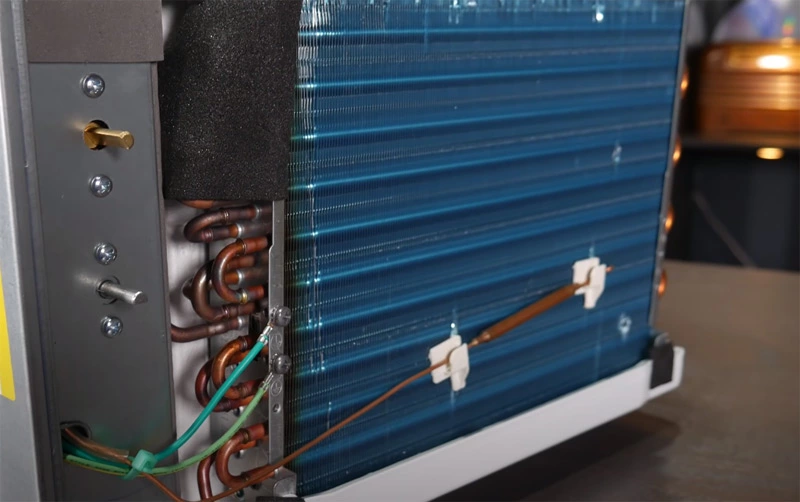
In effect, the heat energy inside the room is being used to warm up the refrigerant as it evaporates. Thinking about this can be kinda weird because we like to think of the evaporator as getting cold, which it is, but it’s getting cold because it’s pulling heat energy out of the air and into the refrigerant inside of it.
Coldness is really just less concentrated heat energy, and since heat likes to go towards cold places to spread out, it naturally finds its way (with the help of a fan). After the refrigerant has absorbed as much energy as it can, it reenters the compressor where the cycle starts all over again.
Once it’s under high pressure, it will be able to condense into a liquid again, releasing the energy it just absorbed to the outside air through the condenser.
Now, I don’t want to get too far into the physics of how this works, nor talk about what makes refrigerants special and why they have been and continue to be a notoriously tricky set of chemicals to manage, so all I really need you to know for this video is there’s a compressor, a hot side, and a cold side.
If we’re cooling a room, we want the hot side outside and the cold side inside. Then we can move the heat energy from inside the room to the outside air, cooling the room.
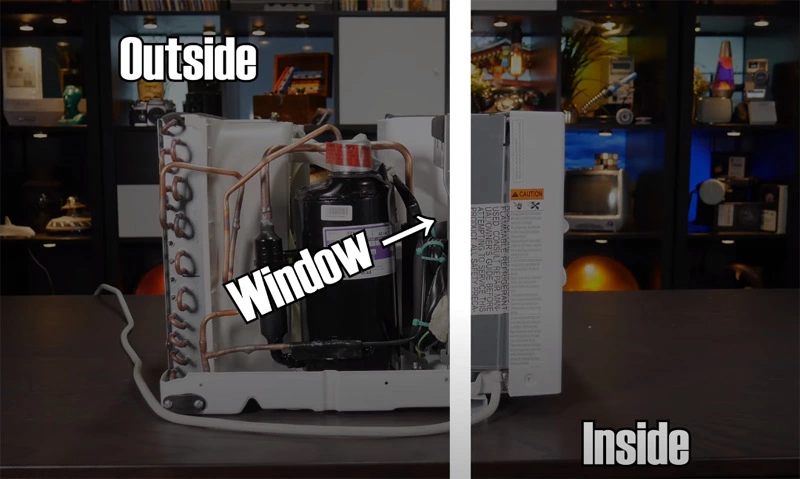
So, let’s take a look at where these components are when the window unit is in operation. When resting in a window, the bulk of the machine is actually outside of the space it’s cooling. The compressor and condenser are both outsides, and thanks to the generous amount of styrofoam insulation, we get a pretty good thermal barrier.
When cooling, none of the actual air in the room is moved outside–only the refrigerant, and thus the heat energy it’s absorbed, makes it out. This maximizes efficiency.
If you have a central air conditioning system, you probably have what’s called a split system. Here, the compressor and condenser (along with a cooling fan) are contained in a single unit that sits outside, and copper refrigerant lines are run into the building to a separate evaporator located in an air handler or incorporated in a furnace.
See? It’s a split system, as the evaporator and condenser are split apart. These systems are highly efficient, with the entire hot side located outside and away from the living space, and only a tiny hole is required in the home’s thermal barrier to moving the refrigerant in and out.
Alright, and now let’s take a look at a portable air conditioner. You may notice that the entire machine is inside. That means not only is the cold side inside, but the hot side is also inside, too. Well. That’s not great.
We want the energy to be absorbed by the evaporator and released into the condenser to make its way outside somehow.
How does a portable air conditioner work?
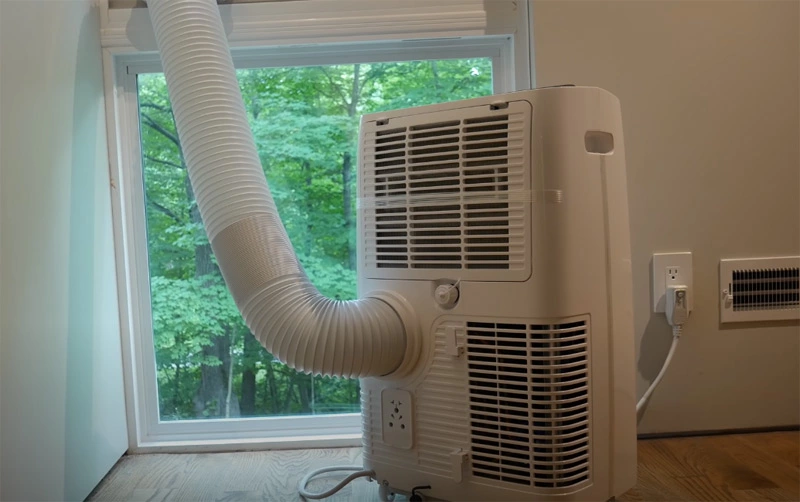
They suck in indoor air through these vents, blow it across the condenser to cool it off, and then push it outside through that hose. That last sentence is very important. They pull in air through these vents, air that they just cooled, mind you, and blow it outside.
That sounds pretty friggin stupid, just on its face. Now, it’s not like it doesn’t work. If these didn’t work they wouldn’t be nearly as popular as they are. Also! Two-hose portable air conditioners, which suck in outside air to cool the condenser and then blow it back out in two separate hoses, are available, but they are an increasingly rare part of the portable air conditioner universe and the vast majority on sale are single-hose units just like this one.
So, if this machine relies on drawing air in through these vent slots to cool the condenser, and then has to barf the now hot air outside, that means not only is it sacrificing some of the cool air it just generated, it’s also creating a low-pressure environment in whatever space it’s in.
Now the air pressure outside the room is greater than the inside. And that means that outside air is going to make its way in through the walls to replenish the air that just left. You can’t just expel air from a room without it getting replaced somehow (otherwise you’re in a vacuum chamber and I advise you leave as soon as possible). And what replaces it is ultimately the hot outside air that you’re fighting against.
Portable air conditioners vs window air conditioners
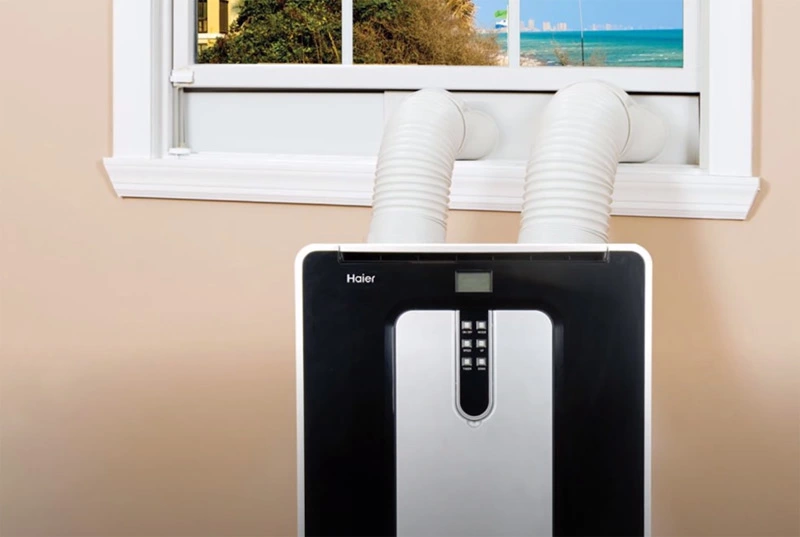
Single-hose portable air conditioners will always be significantly less efficient than a window unit because they’re not just pulling the heat energy out of your room. They’re also pulling the air out, too. In fact, if you go to a hardware store and take a look at a fresh assortment of portable units, you’ll often find that they have two cooling capacities listed these days.
Why? Well, because newer testing methods are accounting for the losses brought about by this hose, so while the unit may technically be able to move 8,000 BTUs per hour, thanks to the warm air it’s drawing back in (as well as its own cold air it’s blowing back out) it’s effectively only moving 6,000 BTUs per hour.
So, basically it’s 25% less efficient. But it’s actually much worse than that!
This little 5,000 BTU window unit consumes 455 watts. If we take a look at this 5,500 BTU portable unit from LG, you’ll see that it uses over a kilowatt! That’s more than double the input power required to generate only 10% more cooling.
If you are not sure how to calculate British thermal unit, please kindly refer to our previous article.
A window unit that consumes that much power can produce roughly double the cooling capacity. Now I’m not here to say that these are terrible devices and you’re a fool if you own one. I’d be calling myself a fool twice if that were the case. But I will say that in general, these should be your last resort.
If you have the option to use a traditional window unit, take it. It’s much more energy-efficient and it will cost less to run.
And yeah, I get it. They’re ugly. They block your view from the window. They’re not exactly attractive from the outside either. But it’s not just energy efficiency that they’re better at.
Air conditioners are noisy. They’re noisy because they’re mechanical devices, with a buzzy compressor and two droning fans moving air around.
With a traditional window unit, the compressor and one of the two fans are outside. Thanks to that thermal insulation, you get a lot of sound insulation, too.
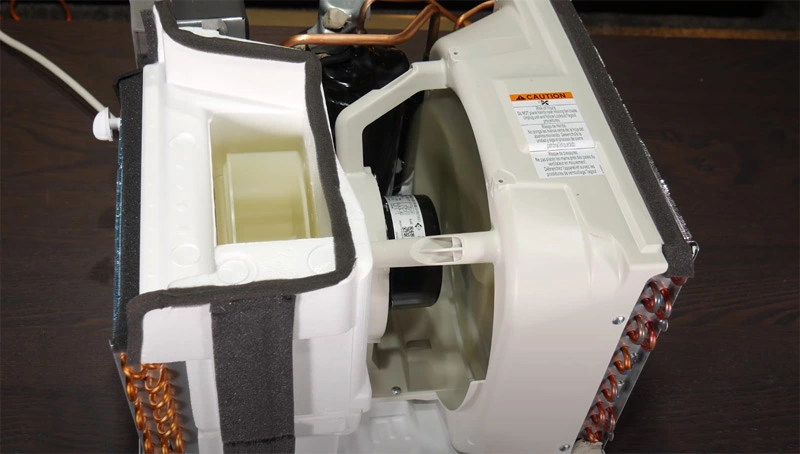
You’ll certainly notice a difference when the compressor is on versus when it’s not, but it’s often pretty subtle. Especially because, as is the case for many windows units, the same motor drives the indoor blower fan and the condenser fan, so the only part that cycles on and off is the compressor. And of course, split systems are even quieter because the loud parts are nowhere near the living space.
Compare that to this thing. Not only is the compressor now inside the room you’re trying to work or sleep in but so is the condenser fan.
The result is that it’s not that noisy when it’s only running the circulator fan. But when its thermostat calls for cooling, it gets way, way louder!
Suddenly, the compressor kicks in (which again, is inside the room), and a second fan turns on to expel the heat from the condenser. It’s a good thing the condenser fan shuts off when it’s not actively cooling, as otherwise, it would suck even more air out the room. But it means there’s a stark difference in noise levels between not cooling.
And if you’re trying to sleep in the same room as one of these, you’ll have to put up with it going from pretty quiet to loud as hell and back over and over again.
This is a cheap in-house brand unit from that place where you save big money so I wasn’t expecting it to be whisper quiet, but I’ve also got a more proper unit from LG that, while a little more elegant in the way it handles the transition from cooling to not cooling and vice versa, is still much much louder when it’s cooling.
I’m a pretty heavy sleeper, and even for me, it can be a challenge to ignore the thing and fall asleep. And another thing to consider is that while window units steal a bigger chunk of your windows, they don’t steal your floor space.
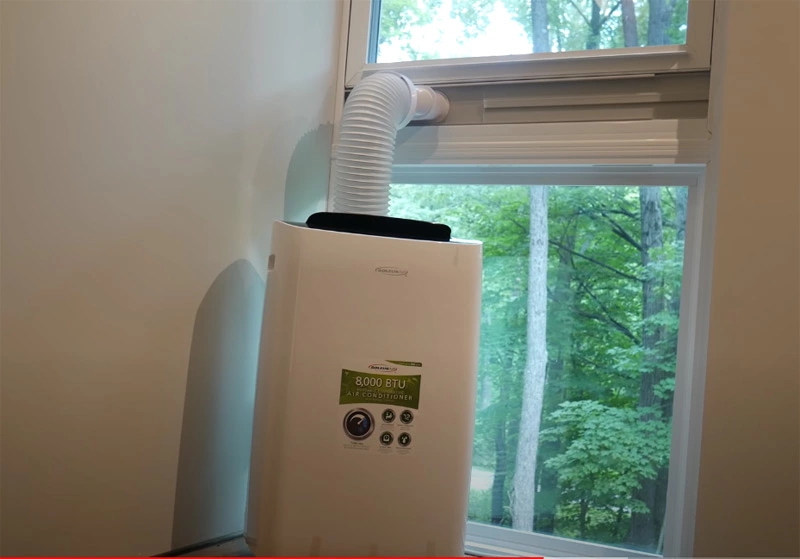
Portable units aren’t small and they can’t sit flush against the wall thanks to the hose, so be prepared to re-arrange a little furniture. And by the way. That hose?
It gets hot!
That heat energy it just concentrated isn’t gonna go away without a fight, and since this hose isn’t insulated at all, some of it is coming right back into the room.
Fantastic.
But, I’ll admit.
Portable A/C units are handy. Really handy. They don’t need proper installation like a window unit does (which is quite a pain, I might add). You can also install portable air conditioner in push out window!
They can easily be moved from room to room thanks to the wheels they’re on (that’s why they call them portable). And they fit window types that might otherwise be unable to accommodate an air conditioner, such as vertical windows or even patio doors.
You could even run them through a small dedicated vent if you choose. But sadly, their single-hose design makes them, honestly, a terrible device when it comes to efficiency.
I’d like to see more double-hose units available for sale. They’re still gonna have the noise and floorspace disadvantages, but they at least regain much of their efficiency back.
Last year I tried a portable mini-split system, with a separate outdoor compressor and condenser unit, and an indoor evaporator unit connected via a flexible refrigerant hose.
Sadly, my unit had a refrigerant leak and stopped working after a few weeks. It looks like that’s a common problem, but let me tell you it was blissful while it worked.
Quiet, efficient, and effective.
I’d like to see this product get more development, but I also understand that it’s got way more limitations than even a window unit.
Unless you want to get creative with some sort of exterior wall bracketing, this is limited to a ground-floor room or a room with a balcony or something similar.
But anyway. If we’re gonna keep using these things, can we please get more dual-hose units?
I get that they’re less flexible, particularly with vertical or narrow windows, and so are probably less desirable, but hopefully, with more people aware of the energy losses caused by continuously pushing the air out of your home, we’ll see increased demand. Still, if you’re looking for an air conditioner in a situation where a window unit could work–you’re seriously better off going with the window unit.
What is better a window or portable air conditioner?
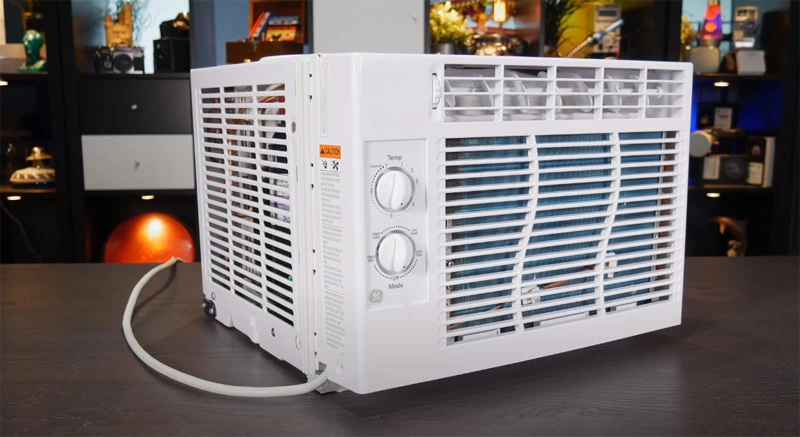
Contrary to what you might think, portable units are certainly not an upgrade. Other than their portableness.
Thanks for reading, and I hope you found this article to be as cool as a correctly charged air conditioning system.
I do want to explore air conditioning a little more because I find it fascinating. The way that we exploit the physical properties of certain gasses to make heat energy move where we want it to go is kinda mind-blowing.
Oh, and by the way, not all refrigerants are crazy complex chemicals. Some small refrigerators and air conditioners are starting to be charged with propane.
Propane, also known as R290, is becoming an increasingly common refrigerant thanks to its abundance and relative environmental harmlessness.
Unfortunately, it’s also flammable which makes servicing these a little tricky, and makes it unsuitable for larger units that need a lot of refrigerants. But especially for small, cheap units like these things that are likely to simply be disposed of when they die rather than actually serviced, it’s a great opportunity to use it.
This machine, though, while it is charged with a flammable refrigerant, uses difluoromethane, or R32.


